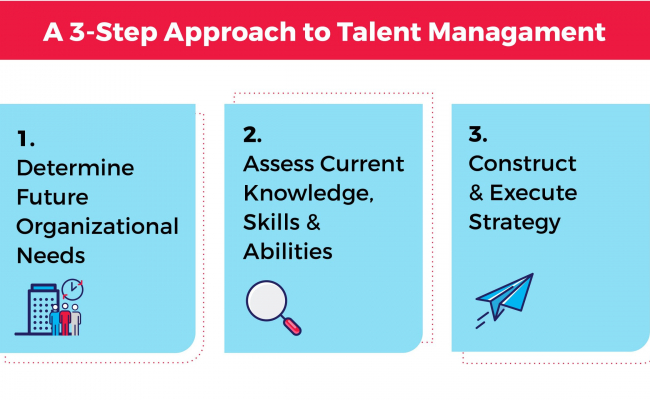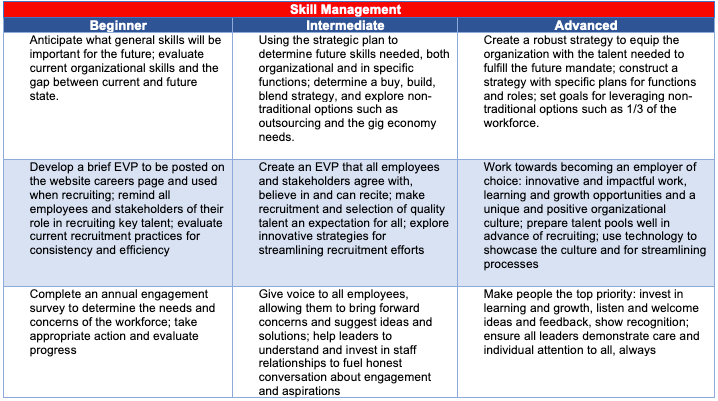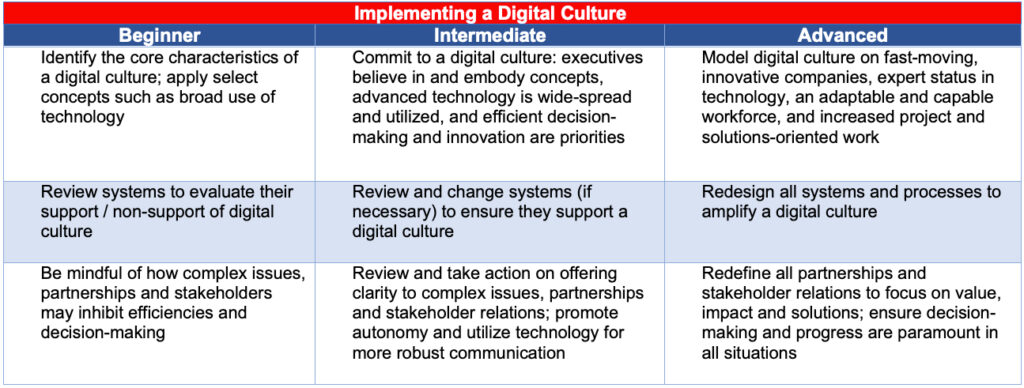Introduction
Management Guru Peter Drucker famously said, “Culture eats strategy for breakfast”, meaning that even the best strategies will prove unsuccessful if the organization’s culture is not aligned.
Organizational culture is a combination of values and beliefs that determine how an organization’s people behave. In essence, it’s the ‘how’ of organizational results. Culture can come in various forms, but as technology has evolved, society, organizations and the workforce has followed suit. We’re smarter, more efficient and more connected (or arguably less, if you consider the amount of screen time versus the in-person time we spend). But how might digital culture impact our world of work? And does Drucker’s concept of omnipotent culture still apply to a world integrated, and perhaps dominated by technology?
This section outlines four different areas related to digital culture in the workplace:
- Talent Acquisition and Retention,
- Leadership and Engagement,
- Change Management and
- Internal Communications.
The concepts presented are intended to equip leaders and organizations with insight and strategies for effectively integrating and leveraging a digital culture. Changing or evolving an organization’s culture takes time, intentionality and discipline, and many of the concepts presented are rooted in solid foundational approaches, now with the onset of a technological spin and shift in mindset.
“Culture eats strategy for breakfast”
– Peter Drucker
Talent Acquisition & Retention
People are the lifeblood of an organization. Finding and keeping the right people can make the difference between achieving the minimum and the impossible. This section outlines a three-part approach to managing talent within the context of creating a digital culture, as well as strategies for attracting and retaining key talent. A 3-Step Approach to Talent Management
1 Determine Future Organizational Needs
With technology and innovation continuing to change how organizations operate, it might seem difficult to predict what skills and competencies the organization might need in the future. Start by applying the organization’s strategic plan in uncovering what is already known. For instance, organizations will continue to face rapid change, and when paired with implementing a digital culture, employees will not only require certain skills, but also a particular mindset that includes adaptability. Identify which characteristics will be needed across the organization at all levels and in all functions, regardless of specific future state (e.g., collaboration, adaptability, comfort with technology, etc.). Which functions will demand different and more specialized skill sets? For instance, will Fundraising Professionals always require relationship management skills – the ability to initiate, evolve, sustain and leverage relationships within a broad network, or will virtual networks and social media be required?
When paired with the strategic plan, these types of questions will help to determine what the organization will need in the future, allowing leaders to move to assessing current talent in the next stage.
In more mature environments, a 9-box talent grid can be used to assess current performance and potential to determine where gaps for succession, and to indicate where and the type of development needed.
2 Assess Current Knowledge, Skills and Abilities
Once future organizational needs have been established, be them general or more specific, current knowledge, skills and abilities (KSAs) should next be assessed. Leaders should focus on the most important 4-6 KSAs needed to fulfill the organization’s future mandate (with certain functions requiring more specific KSAs).
When evaluating KSAs, different approaches can be applied. For instance organization-wide (all employees, levels and functions), by function (critical groups/teams), by level (e.g., leadership positions) or assessing each employee individually.
For example, if new technology will be a key part of the three-year strategic and operational plan, requiring all employees to adapt and integrate, then it follows that openness to change / change readiness will be critical. While formal evaluation frameworks can be helpful, organizational experiences can also prove to be noteworthy. For instance, if an interactive digital communications tool introduced four months earlier is being used by only one quarter of employees because they haven’t the time or interest, then this could be indicative of a broader challenge (obviously this example would require a more detailed understanding). Using these types of organizational experiences and other data points can help to determine the current state of critical KSAs. In this example, leaders must now determine the best strategy to close the gap between current and future state given the importance of technology over the coming years.

3 Construct & Execute Strategy
Upon determining future needs and current KSAs of the workforce, a strategy must be determined and actioned to fulfill the organization’s mandate. The most common strategies are to Build, Buy or Blend.
Build: Training, developing and/or re-skilling the current workforce where possible to meet organizational needs.
Advantages: Current employees remain in the organization with valuable knowledge, experience and relationships; learning and development can fuel engagement, especially for the millennial workforce.
Disadvantages: Requires leaders to be focused on learning and development, which can be challenging if this is not already part of the culture; can be costly and time-consuming; sometimes not feasible based on how extreme the future state needs may be compared to current KSAs in the organization.
Development doesn’t always have to be costly: 70/20/10 model of L&D
Buy: Hiring new employees with the required KSAs to fulfill future objectives.
- Advantages: New hires arrive with the new skills needed, as well as different perspectives from other experiences and organizations
- Disadvantages: New hires will not understand culture and will take some time to get up to speed; markets will determine salaries, especially for in-demand and highly technical roles, which can drive costs and salary inequities with the current workforce
Blend: Perhaps the most common approach involves using both build and buy strategies. This strategy provides flexibility in cost, time and overall investment. For instance, an organization may choose to invest in training to help all employees gain comfort with new technology (build), while seeking an external candidate to lead digital marketing and social media (buy).
While there are different strategies to pursue when ensuring the organization’s workforce is equipped for the future, being intentional and planful about how to accomplish this is key.
Find Future Employees By Speaking Their Language

McDonalds hires thousands of new employees each year, and in 2017, the restaurant empire began using Snapchat to attract and engage potential candidates. ‘Snaplications’, as they’re called, enable applicants to sell themselves through the app, and even try on a virtual uniform. The popular app is used by over 166 million users, many of whom are the same demographic McDonalds is seeking to hire, making it a natural fit for recruitment.
While not hiring in the thousands, McDonalds still demonstrates how to apply a recruitment strategy that engages the needed workforce on their terms – by going where they interact and using their preferred communication channel.
Leverage The Changing Workforce
While more traditional talent approaches have been to build, buy or blend, a changing workforce provides opportunities to utilize talent differently.
Borrow
organizations are deeply immersed in their communities, including the business community. Secondments offer the chance to hire leaders or employees with specific skills on a temporary basis (typically one year). Those on secondments gain great experience while offering value and perspective to the organization. Consider agreements where salaries can be subsidized by the offering business, and even trades where leaders may swap positions for a period of time.
Outsourcing
Outsourcing involves partnering with expert organizations to complete specific work more effectively and efficiently. While it can offer cost-savings, more importantly outsourcing allows organizations to focus on activities that offer the greatest value and impact. For instance, would organizational needs be better served by an IT company versus a trouble-shooting helpdesk employee? Would an HR consulting firm be more efficient at sourcing candidates and completing introductory steps of a recruitment process? Technology and the Gig Economy have created practical and affordable outsourcing options.

The Gig Economy
Today’s labour market has been characterized by the prevalence of short-term contracts or freelance work as opposed to permanent jobs, known as the Gig Economy. This provides opportunities for organizations to obtain specialized skills sets when they are needed most, without the need to hire for a permanent position. For instance, if the organization needed expertise understanding donor analytics, hiring a Data Scientist for two months or one day per week for six months would be more feasible than a full time role.
The Gig Economy may also help to see the needs of the organization through a different lens, in particular untapped labour pools, such as retirees or students. These groups are not likely to be seeking full-time work, but may likely have the right skills and experiences to offer value.
For instance, could a small group of students from a local college be hired to help brainstorm or build a technology solution?
While there are challenges with project-related work, such as sourcing and managing someone who’s had no exposure to the organization, its people, culture or processes, here are some important tips in leveraging the Gig Economy:
- Clarify the mandate and explain organization culture and context
- Specify individual roles, responsibilities, reporting relationships, deliverables and timelines
- Explain where additional information can be found, and streamline any onboarding process
- Investigate and be aware of any employment legalities by consulting an expert
Attracting The Right Talent
Organizations are nothing without great people. And while the charitable sector is not known for paying high salaries and big bonuses, the organization movement has some distinct advantages. Positively impacting one’s community and offering meaningful work, are just two concepts that resonate with many prospective employees, in particular millennials.
Employee Value Proposition
Even with this advantage, many organizations overlook the opportunity to project the employment experience offered. Employee Value Proposition refers to what employees receive in return for their competence and the value they deliver. Put simply, if another organization across the street worked on similar community initiatives, what would compel an employee to work with organization versus across the street? Some might believe the difference is salary and benefits, but going beyond transactional elements of the employer-employee agreement can offer a distinct advantage in recruiting quality talent. For instance, does the organization offer a flexible work environment? Are employees given the autonomy to make critical decisions? Is new technology part of the direction and culture?
The organization’s EVP can be shaped into a statement that represents the culture and experience employees can expect, both as new recruits and current employees. See the example below.
“At Rise Up Strategies, we care about the communities we work in and know what it takes and who needs to be involved to make them best it can be. That’s why we’re focused on supporting our people through learning and growth opportunities, so they feel empowered to make the decisions that have the greatest impact. The work comes with unique challenges and complexities, much like the community needs that drive our work, so we’re always seeking new Community Champions who are passionate about making a difference. ”
-Adam Smith, CEO, Rise Up Strategies
Included are the words learning, growth and empowerment, in addition to the history of the organization and connection to the community. Challenges and complexities are also included, informing interested candidates that the work is both difficult and rewarding.

A finely crafted EVP will help prospective employees understand the organization, and provide current employees consistent language to provide, but it won’t be enough on its own to bring the right quality talent into your organization. Below are three approaches to improving the recruitment and screening process.
Everyone’s a Recruiter
In addition to being ambassadors for the organization, all employees, volunteers and stakeholders should also become recruiters. Quality talent can be difficult to find, and with everyone constantly seeking others who share the same passion and values, the external talent pool should always be full. Set this expectation with everyone and be clear about which KSAs and mindset align today and in more importantly for the future.
Learn About Employee Referral Programs
Better Process = Better Hires
A recruitment process is often riddled with challenges, the most common being biases and time constraints. However, experienced leaders understand the importance of hiring the right people, and the devastating consequences that arise when new employees are unsuccessful. The best way to mitigate against poor hiring is to strengthen the recruitment process. In addition to clarifying the KSAs and mindset needed, the process should involve multiple steps in order to experience candidates in different contexts. For instance, how many current employees and/or volunteers should a candidate meet with before a decision is made? How transparent is the process regarding the realistic challenges in the role and organization? Have less formal discussions occurred where the candidate has been encouraged to ask difficult questions?
Efficiencies and Focus
Recruiting is a time-consuming task. Between reviewing resumes, scheduling meetings, completing interviews and reference checks, leaders are often overwhelmed by these activities in addition to their ongoing responsibilities. In addition to a ready candidate pool, including appropriate planning and anticipation of succession, leaders should seek ways to streamline the hiring process and focus on the areas where they can offer the greatest value. For instance, can pre-interviews or references be outsourced? If writing or public speaking is required, could technology be utilized to see these skills applied (e.g., uploading videos or previous speaking engagements)? If this is a role that interacts with multiple stakeholders, should they attend an event?
Retaining Great Talent
Losing great talent to turnover is not only disruptive to the organization and morale, but also very costly. Turnover can cost up to 1.5x the annual salary of the incoming employee when all recruiting, training and other non-financial costs are totalled, and much higher for more specialized roles and senior leaders. While not all turnover is bad, as sometimes it’s best for people to move on or they have a great opportunity, leaders who take a personal interest in their employees and have regular check-in conversations can reduce the likelihood of unanticipated turnover. In addition, below are three strategies organizations can focus on to retain their best employees.
Invest in Learning and Development
Not everyone is interested in career advancement, but most are keen to grow their skills. Provide opportunities for all staff to learn and develop through different channels such as classroom training, online resources, mentorship, volunteering and experiential learning through exposure and new opportunities. Foster a culture of professional development, ensuring all have individual development plans and that leaders are regularly discussing development.

Listen and Take Action
Those closest to the work understand the issues best, and often have the greatest solutions. Listen to employees at all levels, asking for their insights, ideas and feedback to ensure they feel heard and valued. Formal engagement surveys and other pulse check can also provide data to inform strategies, policies and other action. Take action where possible, and be sure to explain why action could not be taken if not feasible. Leaders should conduct regular stay interviews with all employees to gauge ongoing individual engagement and to address any personal needs. This information also provides insight into unknown issues, and the possibility to predict or potentially avoid turnover.
Recognition as part of the Culture
Everyone wants to be recognized for a job well-done. Show employees how important they are to the success of the organization by sincerely thanking people for their effort and results. Making recognition personal by getting to know how people prefer to be appreciated, and always ensure that recognition is both genuine and timely. Most importantly, recognition is most powerful when it comes from an employee’s direct manager.

Leadership & Engagement
Leading a Digital Culture
While all employees own and shape organizational culture, it can be argued that leaders, given their position and authority, have greater influence and responsibility in shaping the environment. Regardless of the cultural attributes, leaders often decide, intentionally or unintentionally, the values, norms and behaviours that dictate how work is completed in an organization.
In a digital culture, leaders have the opportunity to shape their environment, meaning the ‘how’ of the operation, towards the behaviours, attitudes and skills, that characterize a technology-infused workplace. Beyond the prevalence of technology, which requires a certain comfort, minimum skills and practical use, it may also require a complete shift in mindset surrounding the way work is completed.
For instance, technology may allow for the flexibility to work from different locations, or the use of more project-based workers may reduce the number of core employees in the office and therefore its overall feel. Another example would be a greater willingness to innovate, where leaders begin to ask and evaluate where they are prepared to take risks and even fail in the interest of progress, problem-solving and development. The organization might seek a more intrapreneurial mindset from employees, creating diverse project teams to solve complex problems within a certain timeframe, similar to hackathons in the software development world. Even new language not typically associated with the sector may be used, such as Fail Fast or Minimum Viable Product (MVP).
These types of shifts can be very exciting for an organization, but can also cause difficulty for leaders who are attempting to remain at the forefront of change, while simultaneously leading the core and the laggards. With this is mind, leaders must also review and align the systems and processes that underlie the organization to support digital culture.

The Non-Technical Systems of a Digital Culture
With the organization committed to a digital culture, leaders must not only encourage and act in accordance with ideal behaviours, but also ensure ensuring organizational systems are properly and foundationally supporting. Below are some examples of how systems support culture.
- Leaders take action to address and correct behaviour that contravenes a digital culture (e.g., resisting change or new technology is treated as a performance issue and is supported by the performance management program)
- The recruitment process is weighted towards skills and mindset that aligns with a digital culture and excludes candidates who do not have the right knowledge, skills, and abilities (e.g., technical competence or community connection does not trump open-mindedness and adaptability)
- Learning and development programs and individual plans are all aligned to promote a digital culture (e.g., all employee have at least one digital culture-related development goal)
- Leaders speak openly and regularly about what a digital culture means and the importance of alignment (e.g., digital culture as a standing agenda item at town hall meetings)
- The compensation and incentive strategy supports those with adding the greatest value versus rewarding tenure or loyalty (e.g., employees who are new to the organization with rare, but valuable skill sets are compensated accordingly)
- Leaders’ actions and behaviours align with digital culture (e.g., executives sponsor new initiatives and are the first to integrate new technology)
Clarity and Simplification in a Digital Culture
One of the greatest aspects of organizations are their connections to multiple stakeholders, be it donors, volunteers, donors, community leaders, business leaders, etc. However, this multitude of groups and individuals when combined with an array of complicated community needs, often creates confusion, inefficient processes, delayed decision-making and ambiguity. To remain as effective and streamlined as possible, leaders are best to define the what, who and how of the organization and its stakeholders. Leaders who clarify and simplify these inter-relationships will benefit from more efficient and effective decision-making.

In addition, employees live in an on-demand world filled with access to information. Leaders must use this to their advantage, sharing as much information as possible, and as quickly as possible, utilizing technology to gain feedback, ideas and other insights in a collaborative format. This inclusive approach can increase decision-making speed, as well as commitment and engagement as employees feel deeply ingrained in the organization.
When employees feel informed and have a greater sense of the direction and organizational priorities, they will be equipped to take action when given the autonomy to act in the best interests of the organization. However, when resources are limited, as with organizations and most other organizations, leaders should not tolerate dissenters and underperformers as they slow progress and limit the impact.
